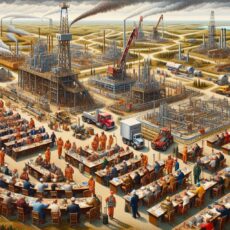The oil and gas industry in Canada is one of the most significant contributors to the nation’s economy. With vast reserves of natural gas, crude oil, and other resources, Canada ranks among the top producers and exporters of energy commodities globally. However, the industry’s complexity is a result of various factors, including environmental regulations, production costs, market fluctuations, and geopolitical considerations.
The oil and gas industry in Canada constitutes an ecosystem that extends beyond exploration and production. It encompasses multiple upstream, midstream, and downstream components essential in the value chain. Upstream activities involve exploration, drilling, and development operations, while midstream activities entail transportation, storage, and processing of the extracted resources. Downstream activities focus on refining, marketing, and distributing the finished energy commodities to end-users.
The upstream operations of the oil and gas industry in Canada have faced significant environmental constraints due to concerns about greenhouse gas emissions, land use, and water pollution. As a result, there have been increased efforts to reduce the carbon footprint of the industry, incentivize cleaner production practices, and promote decarbonization. The Canadian government and industry players have committed to reducing greenhouse gas emissions from Canada’s upstream oil and gas industry by 30% by 2030 through their joint Methane Reduction Initiative.
The midstream sector of the industry is crucial in ensuring that the extracted resources reach the intended markets. In Canada, pipelines have become the preferred transportation method for crude oil and natural gas. However, there are challenges in pipeline construction and maintenance due to opposition from local communities, environmental groups, and regulatory bodies. According to a recent report by the Canadian Energy Regulator, pipeline projects valued at over $25 billion have been canceled or postponed due to regulatory barriers.
The downstream component of the industry focuses on refining and processing the extracted resources into final energy commodities. Canada has a robust refining capacity, with over 21 refineries capable of processing crude oil. However, the refining sector has experienced slow growth due to the increased demand for natural gas and renewable energy sources. The refining industry’s low profitability has also led to the closure of some facilities in recent years.
The oil and gas industry in Canada is susceptible to market fluctuations, with oil prices experiencing periodic volatility in response to supply and demand dynamics. The COVID-19 pandemic’s impact on the global economy has resulted in a decline in energy demand, leading to a reduction in oil prices. Canada’s energy sector has been hit hard, resulting in the loss of jobs and reduced production capacity.
The oil and gas industry in Canada is a complex ecosystem that faces various challenges, including environmental concerns, regulatory barriers, and market fluctuations. Despite these challenges, the industry remains a crucial contributor to Canada’s economic growth and energy stability. It is essential to strike a balance between environmental protection and responsible resource development while securing a competitive and sustainable future.

